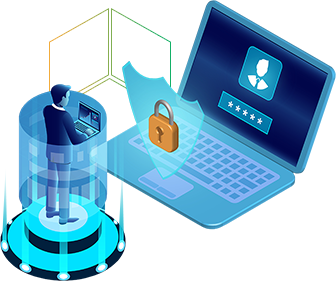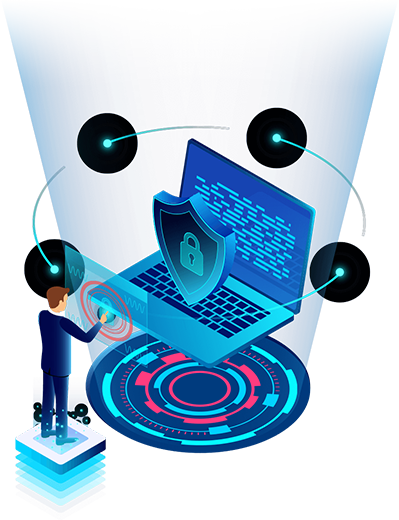Services & Solutions
Expert guide on Cybersecurity
Services We Offer
- Managed Detection & Response (MDR)
- Security Information & Event Management (SIEM)
- User and Entity Behavioral Analytics (UEBA)
- Endpoint Detection & Response (EDR)
- Network Detection & Response (NDR)
- Security Automation, Orchestration & Response (SOAR)
- Security & Compliance Consulting & Product Sourcing
Security Information & Event Management (SIEM)
SIEM – 360 SOC’s Security Information Event Management solution delivers the visibility that SOC teams require to detect, investigate and remediate malicious activity.
Advanced SIEM – 360 SOC’s advanced SIEM has over 250+ Integrations including Syslog, ODBC, SFTP, SCP, FTPS, SNMP, Checkpoint, LEA, WinRM, OpenAPI, Office 365 and many more….For a full list of integrations, contact the 360 SOC sales team.

Security Information and Event Management (SIEM) is a cybersecurity solution that helps organizations detect, respond to, and prevent cyber threats. It does this by collecting and analyzing security-related data from a wide range of sources, including network devices, servers, applications, and endpoints.
SIEM provides organizations with a centralized platform for managing and analyzing security data, enabling them to more effectively detect and respond to potential threats. It uses a combination of machine learning algorithms and expert analysis to identify potential threats, and provides tools and capabilities for responding to and mitigating those threats.
Some key features of SIEM include:
- Data collection and analysis: SIEM collects and analyzes security-related data from a wide range of sources, including network devices, servers, applications, and endpoints. It uses this data to identify potential threats, such as malware, ransomware, and insider threats.
- Threat detection: SIEM uses a combination of machine learning algorithms and expert analysis to identify potential threats. It also provides tools for analyzing and understanding the scope and nature of a threat, such as detailed logs and timeline views.
- Response capabilities: SIEM has built-in response capabilities, such as the ability to isolate infected devices or block network communication, to help mitigate the impact of a security incident. It also provides tools for coordinating and managing the response to a security incident, including incident prioritization, assignment, and resolution.
Overall, SIEM is an essential tool for organizations looking to detect, respond to, and prevent cyber threats. It provides a centralized platform for managing and analyzing security data, and enables organizations to more effectively protect themselves against a wide range of cyber threats.

Customization: SIEM can be customized to fit the specific needs and processes of an organization, including the ability to define custom rules and alert thresholds. This helps ensure that the solution aligns with an organization's existing policies and procedures.

Integration with other security solutions: SIEM can be integrated with other security solutions, such as firewalls, intrusion prevention systems, and threat intelligence feeds, to provide a comprehensive view of an organization's security posture.

Threat Intelligence
360 SOC leverages multiple threat intelligence feeds keeping 360 SOC MDR & SOC customers one step ahead of the cyber criminals.
We use threat intelligence to help organizations protect themselves against cyber threats. We gather and analyze information about current and potential threats from a wide range of sources, including open-source intelligence, industry reports, and proprietary data feeds.
Our solutions are designed to provide organizations with real-time information about potential threats, as well as contextual analysis and interpretation of that information. This enables organizations to take proactive measures to protect themselves and stay ahead of potential threats.
Compliance Specific Reporting
360 SOC has out of the box compliance reporting and compliance templates for compliance frameworks like HIPAA, PCI, PII to name a few.
Flexible Deployment Models
360 SOC’s SIEM can be designed for both On-Premise and Cloud Environment.
What is Advanced SIEM?
Advanced SIEM solutions go beyond basic SIEM functionality by incorporating additional features and capabilities to improve efficiency and effectiveness. These may include machine learning, analytics, and automation to help analyze large volumes of data and identify patterns and trends that may indicate a potential threat. Advanced SIEM solutions may also include integration with other security tools and systems, such as vulnerability scanners and incident response platforms, to provide a more comprehensive view of an organization’s security posture.
Overall, Advanced SIEM can play a critical role in helping organizations protect against cyber attacks and other security breaches by providing real-time visibility and alerting, as well as the ability to analyze and respond to security events quickly and effectively.
What is SIEM as a Service?
Security Information and Event Management (SIEM) as a Service is a cloud or private cloud Hosted SIEM solution, which is a security management tool that helps organizations monitor and analyze their security systems and data in real time. With SIEM as a Service (SIEMaaS), the SIEM software and infrastructure are hosted and managed by a third-party provider, rather than being installed and maintained on-premises by the organization.
One of the main benefits of SIEMaaS is that it can be more cost-effective than traditional, on-premises SIEM solutions. Organizations don’t have to invest in hardware and infrastructure to run the SIEM software, and they can pay for only the capacity they need on a subscription basis. This can be especially appealing for small and medium-sized businesses that may not have the resources or expertise to set up and maintain an on-premises SIEM solution.
In addition to being cost-effective, SIEMaaS can also be easier to set up and maintain. The provider handles all the technical details, including installation, configuration, and ongoing maintenance, so the organization doesn’t have to worry about these tasks. This can save time and resources and allow the organization to focus on more strategic initiatives.
SIEMaaS can also be more scalable than on-premises SIEM solutions. As the organization’s needs change, the provider can easily add or remove capacity to meet the organization’s requirements. This can be especially useful for organizations that experience fluctuations in data volume or security needs over time.
Overall, SIEMaaS provides organizations with an effective security management solution that is flexible, cost-effective, and easy to maintain. It can help organizations protect against cyber attacks and other security breaches by providing real-time visibility and alerting, as well as the ability to analyze and respond to security events quickly and effectively.

What is Managed SIEM?
Managed SIEM (Security Information and Event Management) is a service in which an organization outsources the management and maintenance of its SIEM solution to a third-party provider. The provider assumes responsibility for the day-to-day operations of the SIEM system, including installation, configuration, data collection, analysis, and reporting. The goal of Managed SIEM is to provide organizations with a cost-effective and efficient way to ensure the effectiveness and reliability of their SIEM solution.
With Managed SIEM, the provider typically monitors the organization’s security systems and data in real time, looking for patterns and anomalies that may indicate a potential threat. If a threat is detected, the provider can alert the organization and help it take appropriate action to mitigate the risk. The provider may also offer additional services, such as incident response and remediation support, to help the organization handle security incidents effectively.
Managed SIEM can be a useful option for organizations that want to benefit from a SIEM solution but don’t have the resources or expertise to set up and maintain it on their own. By outsourcing the management of the SIEM system to a provider, organizations can focus on their core competencies and leave the security management to experts. Managed SIEM can also be a more cost-effective option than building and maintaining an in-house SIEM solution, as the provider can handle the infrastructure and technical details and the organization can pay for only the services it needs on a subscription basis.
Overall, Managed SIEM provides organizations with a reliable and efficient way to manage and protect their security systems and data, while also saving time and resources.

Top 7 Reasons
Why Organizations Need a SIEM
Improved security posture:
- A SIEM can help identify potential security threats by continuously monitoring and analyzing security-related data from a wide range of sources.
- By detecting and alerting on unusual activity, a SIEM can help prevent security breaches before they happen.
- A SIEM can also provide a centralized platform for managing security-related tasks, such as updating security policies and deploying security patches.
Compliance:
- Many regulatory frameworks, such as HIPAA and PCI DSS, require organizations to have a system in place for detecting and responding to security incidents.
- A SIEM can help your organization meet these compliance requirements by providing a centralized platform for monitoring and analyzing security-related data.
Early detection of threats:
- By continuously analyzing security-related data in real-time, a SIEM can alert your organization to potential threats that might otherwise go undetected.
- This can help your organization respond to threats more quickly and effectively, minimizing the impact on your business.
Streamlined incident response:
- A SIEM can provide a single platform for managing and coordinating the incident response process.
- This can help your organization respond to incidents more efficiently and effectively, reducing the time and resources required to resolve the issue.
Enhanced visibility:
- A SIEM provides a comprehensive view of your organization's security posture, making it easier to identify potential vulnerabilities and areas for improvement.
- This can help your organization prioritize its security efforts and allocate resources more effectively.
Cost savings:
- Implementing a SIEM can help your organization reduce the cost of responding to security incidents.
- By automating many of the tasks involved in the incident response process, a SIEM can help your organization save time and resources.
Improved efficiency:
- A SIEM can help your organization streamline its security operations by providing a single platform for managing security-related data.
- By automating routine tasks, a SIEM can help your organization reduce the time and resources required to maintain its security posture.
Why 360 SOC?
At 360 SOC, we understand that no two organizations have the same security needs and requirements. That’s why we offer both Managed Detection and Response (MDR) and Security Operations Center as a Service (SOC as a Service), tailored to meet your unique security requirements. Our team of experts will work with you to understand your organization’s specific security needs and goals, and design a customized solution that delivers the protection and support you need to stay safe from cyber threats. With 360 SOC, you can feel confident that your organization’s networks and systems are in good hands, and that you have the tools and resources you need to effectively detect and respond to any security incidents.


